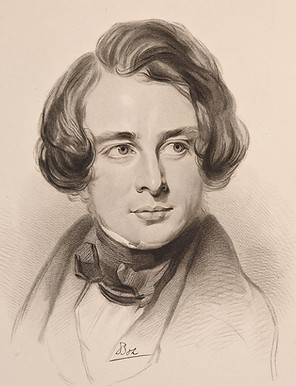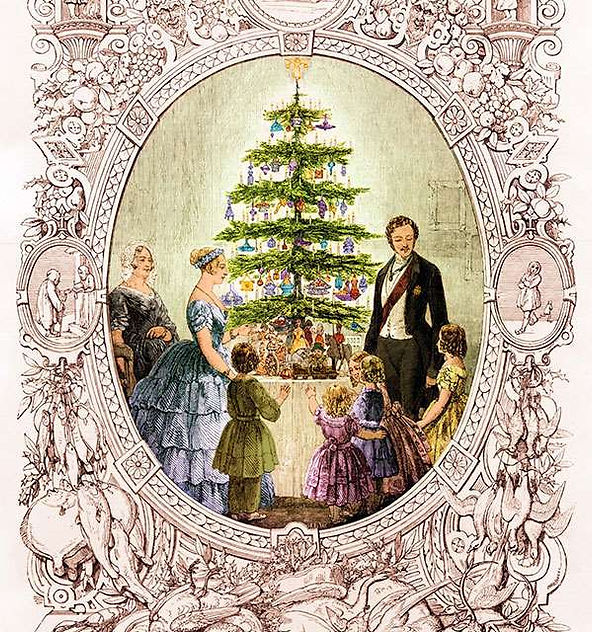


1. ABOUT THE PLAY
Ebenezer Scrooge allowed loss and loneliness to turn his heart cold, and now he thinks that Christmas is nonsense. But this snowy night, three ghosts appear to show him the truth about his past, present, and future. Can Scrooge change before it’s too late?
This holiday tradition at Alley Theatre has been entertaining Houstonians for generations by bringing one of the most famous Christmas stories to life.

David Rainey as Ebenezer Scrooge.
This play is adapted from the original story A Christmas Carol by Charles Dickens.
2. MEET THE AUTHORS

Charles Dickens (1812-1870) was one of England's most influential writers. His best-known works include Great Expectations, Oliver Twist, David Copperfield and, of course, A Christmas Carol. Dickens left a profound impact on society by shaping views on class and poverty and even defining the modern celebration of Christmas.

Rob Melrose is the Artistic Director of Alley Theatre, and he has directed at theatres and taught at universities around the country. He has published translations of many theatre classics as well as his own work. Learn more about Rob here.
Grades 6-12: Meet the Authors
Have students get to know the authors better using this activity.
Click through the slideshow below to discover some fun facts about Charles Dickens, or visit this website.
Grades K-5: Word Bank Bluff
Have students get to know w the language of the time with this activity.
3. WHEN AND WHERE
London, 1843
The Victorian Era (1837-1901), named for Queen Victoria, was a time of rapid change in England - especially in London. New machines revolutionized industry, cities expanded at record speed, and advances in medicine improved everyday life. England rose as a global power, but not everyone shared in its progress: Many children and workers faced harsh and difficult conditions.

Queen Victoria, ca 1845
A Changing Society
Around 1760, people started using machines and steam engines to produce goods instead of making everything by hand. This shift - called the Industrial Revolution - meant factories could create much more, much faster. Cities in England grew crowded as more and more people moved there to work. New inventions improved daily life, and doctors found better ways to keep children healthy. But not everything was great—many factories were dangerous, and even kids had to work long hours. Curious about this exciting (and difficult) time in history? Check out the video to learn more.
Industrial Revolution
4. GOOD TO KNOW
Victorian Christmas
Christmas in early 19th century England looked very different from our modern Christmas. In fact- we can thank Charles Dickens and A Christmas Carol for making Christmas a much more popular holiday.
Learn more about some of our modern traditions that began in the time of Charles Dickens by clicking through this slideshow.



The picture of Queen Victoria and Prince Albert with their children. This image made decorated Christmas trees synonymous with the holiday.
Christmas Around the World
Happy Christmas!
The characters in A Christmas Carol celebrate with some very British traditions: Christmas pudding, mulled wine, holly and ivy, and caroling - to name a few. But did you know that there are different traditions all over the world? Click through below to see some fun ways other countries recognize Christmas.
A Christmas Carol Through the Years
From Radio Plays to Muppet Movies
This story of redemption and hope has become Dickens’ most adapted work in the more than 180 years since its release. Scrooge’s look might’ve changed, but his message has continued to resonate with audiences young and old. A Christmas Carol is the basis for live-action and animated movies, TV shows, operas, ballets, plays, musicals, recorded readings, and even graphic novels. In an age of reboots that get old fast, this tale manages to be the gift that keeps on giving.
1843
A Christmas Carol by
Charles Dickens published
1853
First public reading of
A Christmas Carol
1934
A Christmas Carol begins its annual run
at Alley Theatre
CBS Radio Network dramatization starring Lionel Barrymore.
1989
1992
The Muppet Christmas Carol- a musical adaptation.
Scrooge, or Marley's Ghost - a short silent film - is the earliest surviving film adaptation of
A Christmas Carol
1901
1974
Alley Theatre's first production of A Christmas Carol - a one man show
1983
Mickey's Christmas Carol - an animated short film
2017
The Man Who Invented Christmas released.
2022-now
Current Alley Theatre version!
5. WRITING FOR CHANGE
Richard Henry Horne, a friend of Dickens, reported on a three-year investigation by the Children’s Employment Commission in 1843. With thousands of pages of observations and testimonies, the report drew attention to the serious problem of child labor in Great Britain. Dickens originally planned to publish an essay in response but, in need of money and hoping to reach a wider audience, he decided instead on a short story. With A Christmas Carol, Dickens helped people understand how the Industrial Revolution and its ties to greed had violated the rights of vulnerable people. Much of his work highlighted the plight of poor children - fueling the desire to preserve the innocence and joy of childhood. As public sentiment shifted, foundations like the National Society for the Prevention of Cruelty to Children were established, and various Factory Act laws were passed limiting child labor.

These pictures depict children working in dangerous factory conditions and helped expose the dark side of the Industrial Revolution.
6. WHO'S WHO
Here are some of the characters you'll meet in A Christmas Carol. After you've read about them, take the quiz to see which character you are most like.

Ebenezer Scrooge
A miserly old man who despises Christmas and everything joyful. He is greedy and selfish but has a chance to change for the better when he is visited by a series of ghosts.
Jacob Marley
Scrooge’s former business partner, now a ghost condemned to wander the earth in chains as punishment for his own greed and selfishness. He warns Scrooge to change his ways before it’s too late.


Bob Cratchit and Tiny Tim
Scrooge’s underpaid and overworked clerk, and his young son who has a disability. Despite his hardships Bob is cheerful, loving, and devoted to his family. Tim's optimistic spirit inspires Scrooge to change.
Ghost of Christmas Past
A spirit that shows Scrooge scenes from his own past to remind him who he once was.


Ghost of Christmas Present
A jolly, generous spirit who reveals to Scrooge the joy and hardships of people celebrating Christmas.
Ghost of Christmas Yet to Come
A dark, silent, and foreboding figure who shows Scrooge the consequences of his current path.


Fred
Scrooge’s nephew who loves Christmas and embodies its spirit of joy, generosity, and family. Despite Scrooge’s coldness and rejection, Fred continues to invite him to Christmas celebrations with warmth and patience.
Belle
Scrooge’s former fiancée. She ended their engagement because Scrooge became increasingly obsessed with wealth. Belle represents the life and happiness Scrooge sacrificed.

7. YOUR PART IN THE PLAY
The show can't happen without an audience. Watch the video for some great advice on playing your part.
BONUS ACTIVITY
AUDIENCE ETIQUETTE
After watching the video, improvise scenes where you encounter the best and worst audience members. If you create something fun and want to share it, tag us at @alleytheatre on Instagram or Facebook for a chance to be featured on our social platforms.

8. POST-SHOW TALKBACK
If you and your students plan to participate in the post-show talkback, then here are some way to maximize the experience.



_(14757114.jpg)

